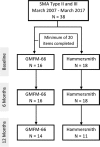Vibration-Assisted Home Training Program for Children With Spinal Muscular Atrophy
- PMID: 29977975
- PMCID: PMC6024344
- DOI: 10.1177/2329048X18780477
Vibration-Assisted Home Training Program for Children With Spinal Muscular Atrophy
Abstract
The aim of this study was to determine the effect of a new method of vibration-assisted neuromuscular rehabilitation in patients with spinal muscular atrophy types II and III. In this retrospective observational study, 38 children (mean age: 4.64 ± 1.95 years) were analyzed. The physiotherapy program, Auf die Beine, combines 6 months of home-based side-alternating whole-body vibration with interval blocks of intensive, goal-directed rehabilitation: 13 days at the start and 6 days after 3 months. Assessments were applied at the beginning (M0), after 6 months of home-based training (M6), and after 6 months of follow-up (M12). Motor abilities were assessed by the Gross Motor Function Measure 66 and Hammersmith Functional Mobility Scale. The Gross Motor Function Measure showed an increase of 1.69 (3.73) points (P = .124) and the Hammersmith Functional Mobility Scale a significant increase of 2.73 ± 1.79 points (P = .007) after 12 months; however, whether this leads to a long-term clinical benefit requires further investigation.
Keywords: children; developmental disability; efficacy; pediatric; rehabiliation.
Conflict of interest statement
Declaration of Conflicting Interests: The authors declared the following potential conflicts of interest with respect to the research, authorship, and/or publication of this article: Eckhard Schoenau is medical director of the UniReha GmbH and Ibrahim Duran is employed by UniReha GmbH.
Figures



References
-
- Wirth B, Brichta L, Hahnen E. Spinal muscular atrophy: from gene to therapy. Semin Pediatr Neurol. 2006;13(2):121–131. - PubMed
-
- Brzustowicz LM, Lehner T, Castilla LH, et al. Genetic mapping of chronic childhood-onset spinal muscular atrophy to chromosome 5q11.2-13.3. Nature. 1990;344(6266):540–541. - PubMed
-
- Lefebvre S, Burglen L, Reboullet S, et al. Identification and characterization of a spinal muscular atrophy-determining gene. Cell. 1995;80(1):155–65. - PubMed
LinkOut - more resources
Full Text Sources
Other Literature Sources

